This blog records the survey and excavation of the old orchard found on the Dominican Sisters of the Congregation of the Queen of the Holy Rosary grounds. This work is being undertaken by the students of CSU East Bay's Field Course in Archaeology class of Spring 2011. Check out our blog and see what we're up to!
Tuesday, June 14, 2011
Identifying Artifacts 6/4/11
Monday, June 13, 2011
Lab Work, End of Class
I had a great time this quarter and enjoyed meeting so many new people. I hope that everyone has a good summer!
Just a quick note to say: thank you!
Here are some pictures of everyone hard at work. Measuring angles to determine excavation unit boundaries:
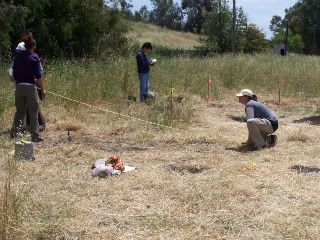
Screening material from Unit 1:
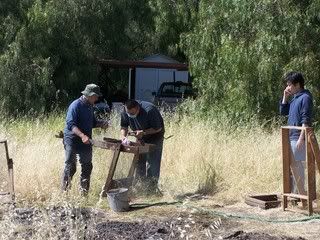
Taking end-of-level notes on Unit 3:
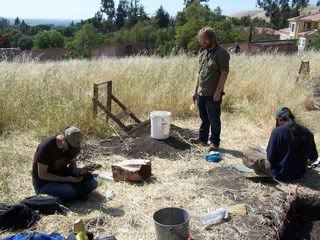
And opening up shop for a new day of excavation:
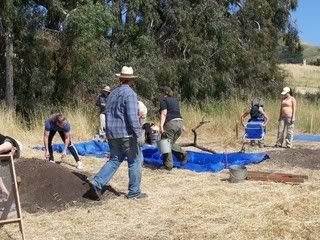
Plus, this turkey:
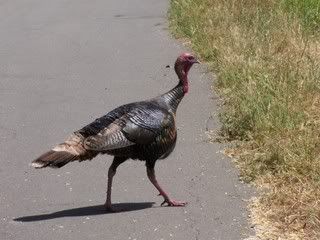
Which reminds me: What do you get when you cross a turkey with a centipede? A drumstick for everybody! Have a good Summer, everyone!
DSCQHR: Epilogue or Epitaph?

as i sit here getting ready to hand in my field note book and finishing up my site report a little waxing on Saturday's events feels appropriate. though i really enjoyed the whole season and truly just now feel ready to begin to excavate with any understanding of how to do it effectively and efficiently, i gotta say that Saturday 11 June 2011 was possibly my best day yet. Charles, his lovely wife Estela, David's B and P, Brenna, Dani, Promise, Ken, thank you so much for helping me to gain closure on an life event that feels as though it is really the beginning of a next phase of my life. doing the profiles and getting to shovel all that soil and muck back into the holes, er units and trench was great. even the repatriation part was the best. thanks to everyone so much for helping me to learn some stuff this past ten weeks. i have this strong desire to go back and do more digging at DSCQHR ... who knows what may happen in the future? ...
Site DSCQHR: really just a dump?
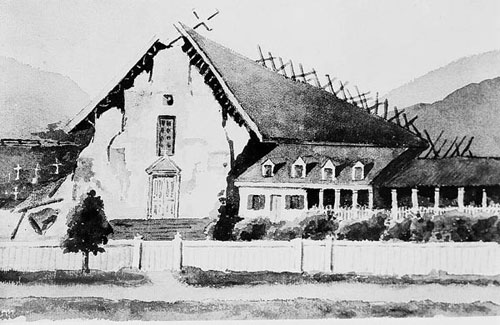
Contemporary image of Mission San Jose following its collapse in the 1868 earthquake.
Here's a thought I had about the deposition at our site, while writing up my analysis section of the site report. Suppose instead of being deposited here in order to building something on top of it, our large area of apparently secondary materials was actually rubble moved here just to clear away somewhere else that someone did want to build/plant on? It would explain why, aside from the road, we haven't found any structures or obvious signs of viticulture such as actual vines, trellises, or other grape-related paraphrenelia. Burning a trash heap is also something people do. Here is the relevant section of my report, with the connection to my own unit:
It is possible that refuse has been dumped on our site area from the mission period onward, but that seems unlikely given its uphill location from the mission settlement. More likely, all of the material, mission, rancho and all, was moved at some point as a whole mass. It is worth considering the fact that we do know for certain, that there was much and sometimes rapid land exchange during the period following secularization, and again following the Gold Rush era. It is also poignant that so little explicitly agricultural has emerged, given the centrality the question of the vineyard has had in some of the proposed hypotheses for this site. I think it is worth considering a hypothesis that I have not yet heard anyone advance, that this midden already existed somewhere down the hill when a land exchange put it in the hands of a new owner, who rather than wanting it to build up a terrace or roadbed, simply wanted it out of their way. Our site may not be the result an attempt to conduct agricultural activities here on Site DSCQHR, but merely an attempt to clear away some old middens or earthquake rubble in order to make some space for agricultural activities somewhere else. Our site may have had value simply as an unused field, as indeed it still is, somewhere a new owner of more valuable agricultural land elsewhere could dump an old trash heap without it being in anyone's way. Nevertheless, this suggestion is also based more on absence of evidence than evidence, and lacks any secondary historical sources to back it up.
According any of the interpretations so far advanced, U3 can be understood as further evidence of this unknown refuse/fill deposition process, and I think the more productive burnt area, especially considering the number of burnt bone and glass, probably represents kitchen refuse. I do not now believe that a feature exists in the unit in the sense of something having purposefully placed there as its original depositional environment, given the lack of any clearly defined boundaries, stratigraphic markers, or widespread regular patterns in artifact distribution beyond certain artifact type clusters and scatters.
Sunday, June 12, 2011
Trench
My Day in the Trench
 |
| Brick, Tile, Cement, Gravel |
 |
| Metal Collection |
 |
| Glass Bead and Myolicka Sherds |
 |
| Bone and Cermanics |
 |
| Bag O Bones |
 |
| Breaking out the Brushes |
 |
| David Measuring the Trench |
 |
| Pavement |
 |
| Cement Block approx 7 1/2cm by 7 cm with 2cm mortice |
Saturday, June 11, 2011
Contrasting Mission



I went to Napa county and found another mission. Since it was a different mission site, I found it interesting to contrast Mission San Jose with this Mission Solano. What I found most interesting was that this mission (in Napa) was the only mission established under Mexican rule. Here are a few pictures of the artifacts that were in the museum. It would have been interesting if we were to find some of the same artifacts that were displayed here in the museum
Day in the field



Friday, June 10, 2011
DSCQHR Fire Insurance Maps - 1916 - 1916/32 Modified

The 1916 Sanborn Map - sheet 1 of 3, for Mission San Jose.

The 1931 Sanborn Map, sheet 1 of 3,(a modified version of 1916) for Mission San Jose
Here are two series of Sanborn maps for DSCQHR for the years 1916 and 1931. For 1931, the 1916 base map was used and the data was modified.
There were some interesting changes in the building footprints as may be seen in the plan views.
These maps also contain insets for the two wineries that operated to the northeast and southeast of our site.
I will refrain from analyzing the maps in greater detail as these data play a prominent role in my version of the excavation report; however, please feel free to utilize the JPEGs for academic purposes and I look forward to reading any ideas any of you have related to the DSCQHR site.
It is my custom to modify these images by using a drafting or photoshop program to generate a unique image and therefore avoid any trouble with copyrights. Again, I have posted these images here in the interest of academic research.
It was an absolute pleasure working with all of you this quarter. Fair Winds and Following Seas - David Pelfrey
Will miss all of you but not that terrible soil!
As I am sitting here writing my site report and reflecting on our quarter filled gophers, turkeys, dirt, trowels, nuns, and more dirt I am sad we weren't able to finish our excavations! It seems we got quite a lot more than we bargained for artifact-wise so that is great but I think all of us would have like to have the satisfaction to get a little deeper! The last day in the lab was really helpful through and gave me a great overview of what we had actually found. There were so many items I had no idea about and are so interesting! I'm wondering if anyone was able to find a circa for that large piece of earthenware in CU 3, found at level 3, this piece was really interesting to me but alas after much research I have given up hope! I wish that we had more stratigraphy to work with in order to have some semblance of order, but unfortunately this site has a mind of its own! I had a great time working with all of you! Have a nice summer!
Thursday, June 9, 2011
I guess i am not as 'Binfordian" as I thought ...
Lab Work
My lab work consisted of the two in-class sessions, the make-up day on June 3rd, and two other sessions where I came in to work under Brenna’s guidance. I therefore was fortunate enough to try my hand at all the different parts of the “lab process.”
The first task I undertook was washing and cleaning the artifacts. At my first day in the lab, Brenna showed me how to place a colander in a bucket of water, and empty the contents of a bag into the water. The colander prevented some of the smaller items from getting lost. Then, taking a toothbrush, we gently removed the dirt. It was really amazing to see the artifacts completely transform once they were clean. There were so many colors besides brown! It was refreshing. For bone and metal artifacts, we took a dry brush and, without getting them wet, we brushed away as much dirt as possible without damaging the artifact. Unfortunately, I learned there is not too much you can do about rusted nails. Very carefully, we then laid each set of artifacts next to their bag to dry on a tray.
During my next experience with lab work, once again the ever-patient Brenna taught a couple of us how to catalog artifacts. We took little cards and filled in the information written on the outside of the bag onto the card. This included things like the site, type of artifact, what unit it was from, unit size, level, depth, screen size, date excavated, and who excavated it. The next day in class, I continued on this task. It was much easier to complete when the whole class was there because we did not all follow one uniform way of recording the information on the bags as we pulled artifacts out of the ground. Sometimes some bags would not have a date, or the name of the excavators. It was easier to fill in these gaps when I could run up to people and ask “does this look familiar?” and “what date was this?” Perhaps it wasn’t the most scientific approach, but I guess it got the job done.
My next day at lab was at the make up day. During this session, Janna and I weighed artifacts and gave them “artifact numbers.” This was also really fun, because we got to get a feel for just how much of each type of artifact was uncovered. We really did uncover a HUGE amount of tile, glass, ceramic, and bone fragments. And to think- we thought we wouldn’t find anything! At this point Promise and Kevin began entering the artifacts into a database. In the afternoon, I tried to date some of the nails, but was not entirely certain on some of my conclusions. Some were clearly from the mid nineteenth century, but for other nails I could not narrow it down at all (literally the guide gave me three centuries for one style!)
My final day in the lab consisted of attempting to date other artifacts. I struggled in vain to get a date for some of the ceramic shards. I figured out that blue transferware appeared beginning in 1750. I tried desperately to match some of the patterns, but unfortunately we just did not have enough of the pattern to find its maker. The prior week, I believe it was Promise who had some better luck. One fragment had a bit of a maker’s mark- John Maddock. She was able to date this to exactly 1896 in the late Edwardian style.
